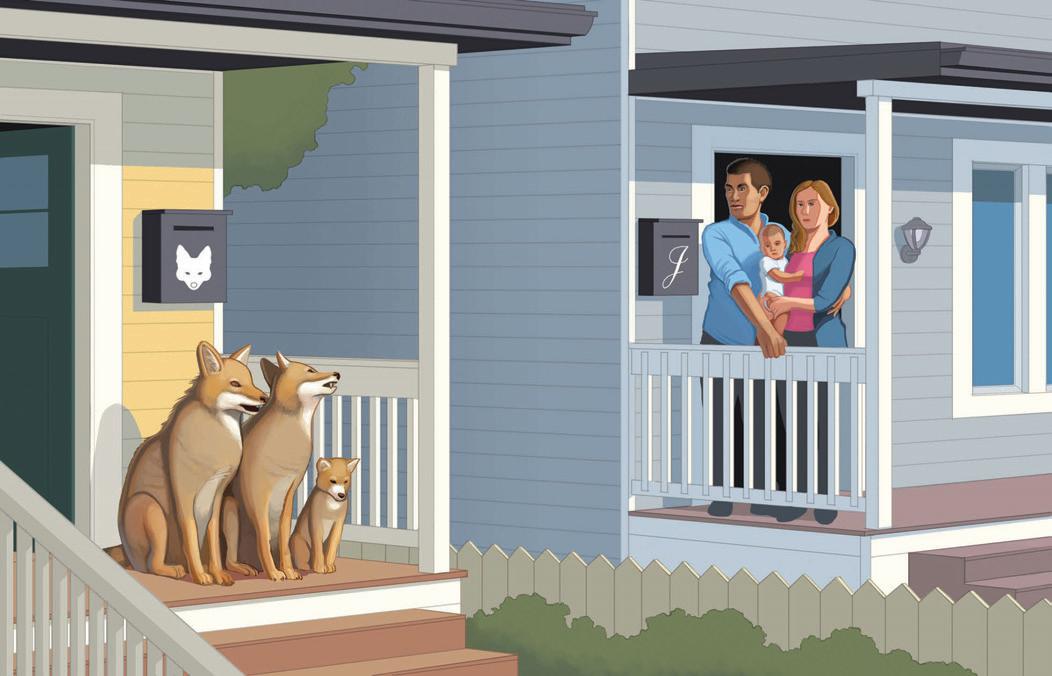
14 minute read
Arch City | Wildlife
Keeping Up with the Coyotes
Columbus has had an influx of canine citizens in recent years, and residents must learn how to live with their wild new neighbors.
By Chris GAitten
Even before the intruder arrived, Suzanne Kloss was alarmed. Earlier in the month, a dog had been carried off from its owner and killed a few streets away. Then, on Jan. 16, Kloss was in her home in Berwick when she heard her pet barking up a storm in the back yard.
The previous pet attack had worried Kloss, and she’d been researching coyotes before her brush with one. She wanted to alert her neighbors and give them advice, so she posted a warning on Nextdoor, a social networking website. That same evening, only a couple of miles away, a coyote bit a Columbus police officer on an I-70 exit ramp near Hamilton Road. To Kloss, the message was clear: Coyotes on the East Side were becoming brazen because they were habituated to people. She formed the Berwick Area Coyote Coalition to share information online with residents.
Such groups are crucial in dealing with coyotes because they can communicate sightings among members and report incidents to officials, says Stanley Gehrt, an Ohio State professor. Gehrt has been studying coyotes in cities for two decades, ever since they began appearing in Chicago, where he’s a wildlife expert. His Urban Coyote Research Project investigated the phenomenon as the animals proliferated in the Windy City and elsewhere, including Columbus.
The reason for their metropolitan migration is still something of a mystery. Gehrt says the best guess is that a severe drop in hunting and trapping rural populations caused their numbers to grow; because they’re territorial, some were pushed toward cities. Coyotes, at about 4 feet long and averaging 25 to 35 pounds, thrived in urban areas. Their diet is broad—rodents, deer, fruit—and they’re opportunistic, so they sometimes take advantage of human sources, like wasted food or the occasional small family pet. They’re quick to adapt, and Gehrt’s research has documented them crossing roads—the most challenging city problem for terrestrial animals—by learning traffic patterns.
Now that coyotes have staked a claim, people are unlikely to force them out. If a solitary coyote is killed, another fills its territory in short order. They can increase litter sizes dramatically, so relocating a group will just have a temporary effect. “The only option would be to somehow introduce wolves and get them established, and I don’t think that’s a viable option for cities,” Gehrt says with a laugh. “So we can’t change their numbers, but what we can do is we can change their behavior.”

His research has focused on ways to reduce conflicts, which are very rare, he says, and even sightings aren’t frequent despite the coyotes’ growing presence. The most common cause of conflict is humans providing food. Some people feed coyotes directly, but it’s unintentional for many homeowners. They leave pet food out or set up bird feeders, which also attract squirrels and small rodents, bringing coyotes into proximity with people and pets when they come looking for a meal.
Kloss believes a neighbor’s compost pile— stocked with leftover fruit from the person’s catering business—may have attracted the coyote to her fence. She has been using the Berwick Area Coyote Coalition’s social media accounts to provide tips for deterring them and to warn others about providing food sources. As she realized early on, the underlying problem is that some urban coyotes have become comfortable, undaunted by their human neighbors. She made her back yard inhospitable, removing the type of brush where they sometimes like to make dens and adding blue strobe lights, which she moves periodically to keep them uneasy, as well as motion-sensor sprinklers and lights.
If coyotes are spotted near homes, Gehrt recommends yelling and making noise—a coffee can filled with coins works well—to scare them away. To live in close quarters without conflict, they need to be afraid of people, he says. In other words, the most neighborly gesture is to be (mildly) menacing.
“Coyotes are here to stay,” Kloss says, and her coalition aims for peaceful coexistence. She notes that the interlopers do provide some benefits, like keeping rodent populations in check. “They’re not bad animals, and they can’t help that they’re coyotes.” ◆

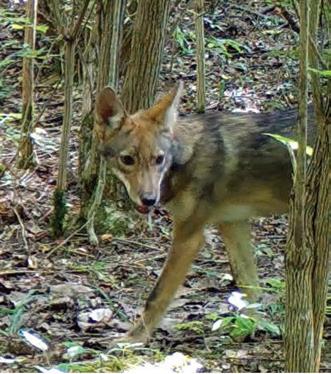
columbusalive.com
the Arts the Eats the Community and more
Stay up to date by signing up for our newsletter
@columbusalive
THE WORLD NEEDS NURSES. THE WORLD NEEDS YOU.
Nurses are a gift to the world. With your generosity, you can pay it forward with the gift of nursing education at Mount Carmel College of Nursing. There’s no greater return on investment than ensuring highly-skilled nurses will be there for their patients tomorrow, and all the tomorrows to come. Please join Mount Carmel College of Nursing’s alumni and friends by becoming a donor today.
To learn more, visit mccn.edu/giving.

mccn.edu
The Columbus Book Boom
Local authors are cranking out collections about the city’s history, attractions, identity and more.
At some point civic pride became a cottage industry, and the local love has extended into literature, with new Columbus-centric books hitting shelves regularly. The five highlighted here have been released in just the past year (occasional Columbus Monthly contributors produced three of them: “111 Places in Columbus,” “Columbus Noir” and “The Columbus Anthology”). With the coronavirus forcing many of us to hole up indoors, and only so many hours one can spend watching Netflix, it’s the perfect time to catch up on reading. —Heather Barr
By John Clark If you’re spending self-isolation preparing for off-the-wall questions at bar trivia, this book—subtitled “Fascinating, RealLife Stories About Unusual People, Places & Things in Ohio’s Capital City”—is the one for you. Learn about odd attractions, like a 1903 stage play with eight galloping horses, and scandals, like a 19th-century pharmacist who loved to sunbathe atop his castle in the nude.
By Ken Schneck and Shane McClelland The images and extended captions in this photojournalistic retrospective give an intersectional look at 50 years of Columbus’ LGBTQ history. It offers details on everything from the underground Berwick Ball in the ’60s to the city’s first Pride parade in the ’80s to the protestors in the 2017 parade who became known as the Black Pride 4. In addition to the historic photos, newspaper headlines and other artifacts underscore the strength of the Columbus LGBTQ community through the decades.
“111 Places in Columbus That You Must Not Miss”
By Sandra Gurvis This compilation of short articles serves as a wide-ranging primer on the city’s quintessential places to eat, drink and explore. From professional and amateur sports to the lively arts community, Gurvis examines hidden gems and Columbus staples in this insider’s guide. The book’s 111 full-page color photographs by Mitch Geiser provide a portrait of the city’s historic landmarks, modern attractions and obscure eccentricities, like a stuffed pigeon named Pete in the Statehouse cupola.
Edited by Andrew Welsh-Huggins This collection of fiction by a group of 13 local writers, including Lee Martin, Nancy Zafris and Chris Bournea, is perfect for fans of crime novels and mysteries. The book tells stories of Columbus’ dark doppelganger, where greed and pride have run rampant. Although they’re fictional, they delve into aspects of the city that are all too real: the opioid epidemic, murder and corruption.
Edited by Amanda Page Unlike Cleveland and Cincinnati, Columbus has always seemed prone to identity crises. This collection features local writers, artists and musicians sharing their perspectives on what, exactly, the city was, is and could become. Poet Maggie Smith wrestles with the ugly legacy of the city’s namesake, essayist Hanif Abdurraqib offers his take on the unifying power of the Crew, and Anyway Records founder Bela Koe-Krompecher reflects on the rise and eventual dissolution of the city’s 1990s-era rock scene.
Buckeye search Party
Maybe John Kasich will get his shot at being president after all. When Michael Drake announced his pending retirement from Ohio State’s top job, the former governor’s name quickly emerged as a possible hire. It wouldn’t be unprecedented. In 2012, Bill Funk’s search firm helped Purdue hire Indiana Gov. Mitch Daniels.
Funk also conducted the search that lured Drake away from UC Irvine in 2014, and he says that year’s board was keen on hiring a sitting president. Though OSU chose another firm to run its 2020 search, Funk’s impression from talking to board members this time was they were interested in looking outside academia as well.
He says there’s a growing appetite for nontraditional options. Otterbein had discussions about that in 2018, says Cheryl Herbert, who led the board’s presidential search committee that year. But the school eventually opted for John Comerford after focusing on eight higher ed semifinalists, including some provosts and vice presidents, the ranks where Funk looks for rising talent.
So when Drake steps down this summer, who will step up? —Chris Gaitten
The insiDers
Executive VP and provost Bruce McPheron is an alum who knows the culture, and he oversees 15 osu colleges and five campuses. In contrast, Dr. harold “hal” Paz is a newcomer, but the June 2019 arrival already oversees the $4 billion Wexner medical Center’s moneymaking machine.
The JiLTeD
Gordon Gee has never suffered from lack of charm, but why not give the current West Virginia president a third time at the helm anyway? Jim Tressel’s tenure as football coach ended too early for many osu fans, and now he has the requisite academic experience as the president of youngstown state.
The acaDeMics
Alum nancy Zimpher was the dean of osu’s professional colleges before leading three schools, including the university of Cincinnati. After poaching Wolverine football coaches Greg mattison and Al Washington, the ultimate insult to michigan would be enticing president Dr. Mark schlissel into a scarlet-and-gray suit.
The caBineT
Funk says he’d look at ex-cabinet members, and who better than condoleezza rice—the former secretary of state, stanford provost and College Football Playoff committee member? or osu could go the medical route with Kathleen sebelius, obama’s secretary of health and human services and the daughter of former ohio Gov. John Gilligan.
The MavericKs
John Kasich has name recognition, experience leading a complex organization, and—as was the case with mitch Daniels—he appointed nearly every board member. but no one has the influence of Les Wexner, who may decide to spend his new free time running osu, as some have long suspected anyway.
Funny Business
Hashtag’s new digs highlight the growth of Columbus’ comedy scene.
By Brooke Preston
Over the past eight years, Hashtag Comedy has built a reputation as one of the city’s finest improv teams, growing from a single troupe into an organization boasting five different shows and casts. Still, there’s one thing Hashtag hasn’t had until now: a venue of its own. “As we grew over the years, we asked, ‘Is this something that we can execute? Is Columbus ready for something like this? Are we?’” says Hashtag’s artistic director Sarah Storer.
The answer is a resounding yes (or, more aptly, yes and …). The Hashtag Comedy theater is currently slated to open this summer at 346 E. Long St. in the Discovery District, with capacity for up to 99, though Storer says the adaptable venue will largely host intimate shows for around half that number, as well as space for classes, a bar and possibly food. It won’t strictly feature improv, welcoming styles from stand-up to sketch and beyond. “We will still have those tried-and-true shows that feel familiar. But we also want to have shows when audiences say, ‘Wow, I don’t ever get to see anything like this anywhere else.’”
Barbara Allen, co-founder of Columbus Unscripted, introduces a comedian at the Stand Up for Stand Up open mic night at Wild Goose Creative.
Hashtag’s new venue is just the latest sign of the city’s ever-growing scene, proof that there’s no better time to be a Columbus comedy fan. Here’s a closer look at a few other local groups aiming to delight.
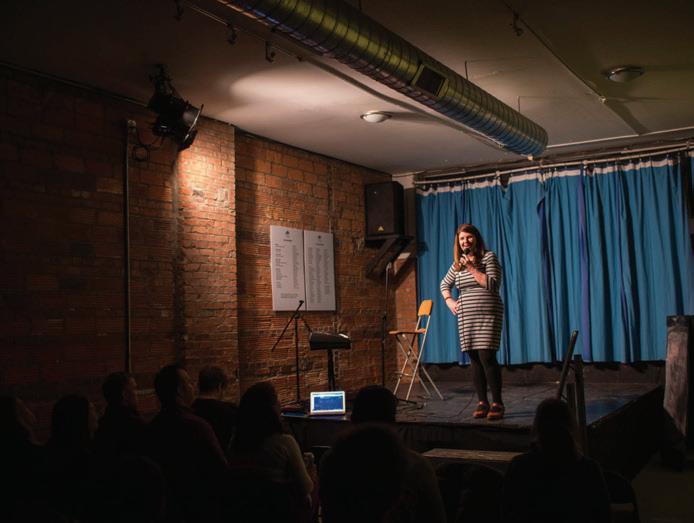
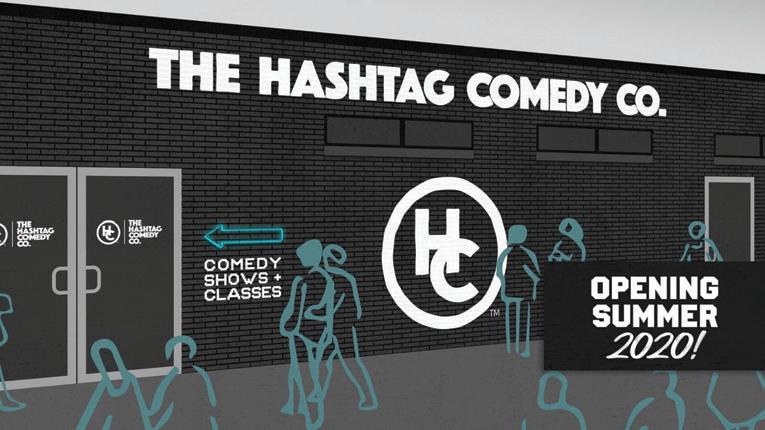
story Club Columbus
Harmony Cox hosts this live monthly storytelling showcase at Rambling House (310 E. Hudson St.), a folky gem of a bar/ performance space. Every first Tuesday, performers are given eight minutes each to regale the crowd with a true tale loosely related to a monthly theme. “story Club is not a stuffy recitation or a serious lecture series,” says Cox. “It’s lively and funny, full of laughs and surprises.”
MadLab
The nonprofit MadLab Theatre (227 N. Third St.) is a performer’s laboratory. In addition to full-length original productions and a young writer’s program, MadLab is also home to some of the city’s greatest comedy troupe shows, from the long-running and always funny FFn to monthly live performances of It’s All Been Done radio Hour (a PG-13 twist on the radio serial), created by producer Jerome Wetzel.
the nest
After a few moves, this multiformat comedy and theater operation co-owned by Tara DeFrancisco and Rance Rizzuto settled in a permanent home at 894 W. Broad St. in Franklinton. Among other shows, The Nest is home to Comedysportz Columbus and “Here the Musical,” a two-person improvised play. One of the first Central Ohio improv training centers, it also offers corporate workshops and classes for hobbyists and aspiring professionals alike.
Wild Goose Creative
Wild Goose is a nonprofit arts organization with a community space (2491 Summit St.) that hosts Columbus Unscripted’s stand-up show every fourth Monday, as well as sassy Do, the city’s longest-running all-female improv group. As Sassy Do co-founder Barbara Allen explains, the performers focus on improv “through the lens of the female perspective. … The heart of our work is demonstrating the power of female friendship to change the world.”

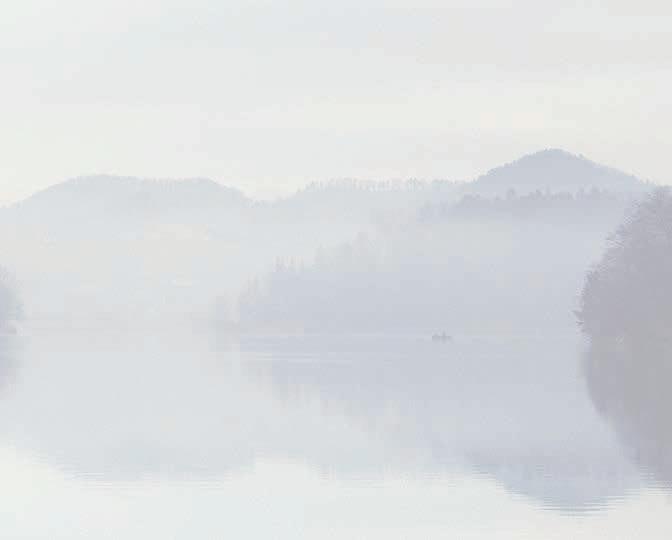



Mouths of Babes


Christine horvath started performing on comedy stages in 2012, after a breakup. “It was a bad time that comedy made a little better,” she says. Despite its uplifting qualities, the experience opened her eyes. “When I started in comedy, a ‘diverse’ lineup looked like four white guys and one white woman, or four white guys and one person of color. “I got out of mainstream clubs. I made a deliberate decision to take myself out of places like the Funny bone and make spaces for me and the audiences I want to serve. I wasn’t making the audiences I wanted to make laugh, laugh.” that’s why horvath created Babe Roar, an organization dedicated to “celebrating and uplifting marginalized comedians,” per the website. When it comes to the work that needs to be done to foster more inclusive stages, horvath is proud of Columbus. “nationally, we have a ways to go,” she says. “locally, we’re doing great. A lot of people have told me that hearing the idea [for babe Roar] encouraged them to book more female headliners because they’d never thought of it before. I’ve also been doing a lot of work toward diversifying lineups because people should see lineups that look like them. Anyone who wants to come to a comedy show should feel represented by the lineup. “Every second saturday, I run Go big or Go home: A big babe Variety show with Fat babes of Columbus and the big Girl burlesque that is specifically catered toward fat babes.” Despite her advocacy and optimism, there’s still a ways to go. “there are lots of people who are not being seen or respected,” horvath says, “and it’s important to represent everyone.” —Amanda Page
YOU’RE NOT ALONET ALONE ...we’re here to help
ARE YOU STRUGGLING WITH
• Anxiety • Depression • ADHD • Bipolar Disorder • Trauma/PTSD • Mood Disorders • Substance Abuse • Schizophrenia
To learn more or to schedule a confi dential appointment, please call GLOBAL WELLNESS CENTER 614-523-2929











